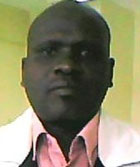Journal of Anthropology & Archaeology, 1(1), pp. 12-27.
Abstract
Kerio valley is one of the driest areas in the republic of Kenya. The region is inhabited by the Keiyo and Marakwet sub-groups of the Kalenjin speaking people. The Keiyo inhabit the south while the Marakwet occupy the northern part of the region. Oral traditions state that the communities settled in the semiarid valley in small agnatic clans in early 1800s and have for hundreds of years used indigenous irrigation furrows to enhance food security through food crop cultivation. Kerio Valley experiences an annual rainfall of 900-950mm per year which mostly falls in the months of May and August with intermittent dry spells within the months. Irrigation activity, therefore, supplements the insufficient rain. The Marakwet introduced the irrigation by tapping water from perennial rivers such as Embobut, Arror, Embomon, Enou, Tunyo, Chebilet, Kiptinos, Embolot and Chesegon. Recent studies show that Tot Division is highly plagued with hunger. Although the area has many irrigation furrows, it is perennially dependent on food relief by government and other agencies. Decay of the irrigation systems and increased population are the main factors that have directly contributed to food insecurity in the valley.
Full Text: PDF
Kipkorir, Daniel., & Kareithi, Joram. (2013). Indigenous Irrigation and Food Security in Tot Division, Kerio Valley, Keny. Journal of Anthropology & Archaeology, 1(1), pp. 12-27.
Adams W.M., Elizabeth, E.W., and Samuel, K.M. et. al. (1997) ‘Water, rules and Gender: Water Rights in an Indigenous Irrigation System, Marakwet, Kenya’. Development and Change vol. 28: 707- 730.
Akong’a, J. and Kareithi, J. (1998) ‘Traditional Management of Drought and Famine in Kenya’, In Bruins J.H. and Harvey L. (Eds) The Arid Frontier: Interactive Management of Environment and Development. Kluwer Academic Publishers: Dordrecht. Pp165-184.
Bryceson, D. (1990) Food Insecurity and Social Division of Labour in Tanzania 1919-1985. London: Macmillan.
Bourenane, N. and Mkandawire, T. (1987). The State of Agriculture in Africa. London: Codestra.
Critley, W. Agricultural Development in Marakwet. In B. E Kipkorir, R.C Soper & J. W Ssennyonga (Eds) Kerio Valley: Past, Present and Future: Nairobi. Institute of African Studies, University of Nairobi, 1982: 1-11.
FAO (1995) Irrigation in Africa in Figures. Rome: FAO.
Government of Kenya (2007) Marakwet District Economic Recovery Strategy Implementation Progress Report, 2002-2006.
Government of Kenya (2009) Marakwet District Development Report 2002-2008. Kapsowar: Ministry of Planning Development. Nairobi: Government Printer.
Government of Kenya (2009) Marakwet District Agricultural Report 2002-2008. Kapsowar: Ministry of Agriculture.
Government of Kenya (2011) National Food and Nutrition Security Policy. Nairobi: Government Printers.
Kipkorir, B. and Ssennyonga, J. (1985) Socio-Cultural Profile of Elgeiyo/Marakwet District. Nairobi: Ministry of Planning and National Development: Uzima Press.
Kipkorir, B. and Welbourn, F (2008) The Marakwet of Kenya: A Preliminary Study. Nairobi: Second Edition. East African Education Press.
Kipkorir, D. and Kareithi, J. (2012) ‘Natural and Human Factors in the Deterioration of Indigenous Irrigation
Furrows in Marakwet, Kenya’. International Journal of Humanities and Social Science Vol.2 No. 18 October 2012 p113-128.
Liyama M., J. Maitiima and P. Kariuki (2007) ‘Crop-livestock diversification patterns in relation to income and manure use: A case study from a Rift Valley Community, Kenya’. African Journal of Agricultural Research vol.2 (3) pp058-066.
Moore, H. (1986) Space, Text and Gender: Anthropological Study of the Marakwet of Kenya. Cambridge: Cambridge University Press.
Ngaira, J. (2009) ‘Challenges of Water Resource Management and Food Production in a Changing Climate in Kenya’. Journal of Geography and Regional Planning Vol. 2 (4) pp 097-103.
Olenja, J. (1982) Dietary Patterns of the Marakwet of Kenya. In B. E. Kipkorir, R.C. Soper & J. W. Ssennyonga (Eds) Kerio Valley: Past, Present and Future. Nairobi: University of Nairobi, Institute of African Studies):112- 119.
Osteberg, W. (2004) ‘The Expansion of Marakwet Hill-Furrow Irrigation in the Kerio Valley of Kenya’. In J.Widgren and J. Sutton (Eds). Islands of Intensive Agriculture in Eastern Africa. Oxford: James Currey.
Relief web report 2012 Kenya: KRCS Wins Marakwet and Pokot Communities Support on Food security Project. http://reliefweb.int/report/kenya/krcs accessed on 15/4/2013
Sutton, J. (2004) ‘Engaruka: The Success and Abandonment of an Integrated Irrigation System in an Arid Part of the Rift Valley, From Fifteenth to Seventeenth Centuries’. In J.Widgren and J. Sutton (Eds). Islands of Intensive Agriculture in Eastern Africa. Oxford: James Currey Press, 124-132.
Sutton, J (1973) The Archeology of Western Highlands of Kenya. Nairobi: British Institute in Eastern Africa. The Star News Paper Thursday November 1 2012 ‘Sh 300 Million Pokot and Marakwet Irrigation project’.

Mr. Daniel Kipkorir is a Curator at the National Museums of Kenya (NMK) and a Part Time Lecturer at the Department of Anthropology and Human Ecology, School of Arts and Social Sciences, Moi University. He graduated from the University of Nairobi in 1994 with B.A (Hons) in Anthropology. He joined NMK in1996 as Research Fellow at the Department of Ethnography and was appointed Curator in 1999. In 2004, he worked at Kabarnet Museum and assisted a team of American researchers led by Dr. Andrew Hill of the Yale University in anthropological projects undertaken in Tugen Hills and Baringo Basin. He returned to the University of Nairobi in 2005 to pursue post graduate Diploma in the Care and Management of Heritage and Museum Collections.
In 2007 he joined Moi University to pursue MPhil in Anthropology and completed in 2009. Currently, he is a PhD Candidate in Anthropology in the same university. His research interest in anthropology includes material culture and museology, indigenous knowledge systems, human evolution, archaeology and conservation of historical sites and monuments. He participated in international anthropological field school in Karonga, Malawi in 2009 with students from Germany, Ethiopia, Tanzania and Malawi. He has published and edited articles in international journals. Kipkorir is a member of British Institute in Eastern Africa, International council of museums, international council of museums of ethnography and African council of museums.

Dr. Joram N. Kareithi is a Senior Lecturer in the Department of Anthropology and Human Ecology, Moi University, Kenya. He graduated with a BA (Hons) in Anthropology from the University of Nairobi in 1989, MPhil in Anthropology (University of Cambridge) 1991 and a DPhil (Moi University) in 2000. Before joining Moi University he worked in the Ministry of Culture and Social Services in the Government of Kenya as a District Cultural Officer in charge of Marsabit District.
He was Head Department of Anthropology and Human Ecology, Moi University 2005-2011 and is currently the Graduate Studies Committee, School of Arts and Social Sciences, Moi University. His research interests are in, Economic Anthropology, Development Anthropology, and Political Anthropology. He has recently carried out research projects in Drought Planning and Rain Water Harvesting among the Turkana of North-West, Kenya under the Netherlands Israel Research Programme (NIRP); Urban Poverty under the Robert McNamara Fellowships Programme (World Bank Institute) ; The Challenge of Orphan Fosterage in the Era of HIV/AIDS in North Rift Region, Rift Valley Province, Kenya, Sponsored by Organisation for Social Science Research in Eastern and Southern Africa (OSSREA); and was an Anthropological Advisor on a research project on Urban Land Delivery System in Eldoret Municipality, Kenya under Birmingham University. He has published articles in journals and book chapters in these areas of research.
Contact Number +254 733560634
Email address: [email protected]
Browse Journals
Journal Policies
Information
Useful Links
- Call for Papers
- Submit Your Paper
- Publish in Your Native Language
- Subscribe the Journal
- Frequently Asked Questions
- Contact the Executive Editor
- Recommend this Journal to Librarian
- View the Current Issue
- View the Previous Issues
- Recommend this Journal to Friends
- Recommend a Special Issue
- Comment on the Journal
- Publish the Conference Proceedings
Latest Activities
Resources
Visiting Status
| 209 | |
| |
297 |
| |
7543 |
| |
8696 |
| 940432 | |
| 12 |
 The Brooklyn Research and Publishing Institute
The Brooklyn Research and Publishing Institute